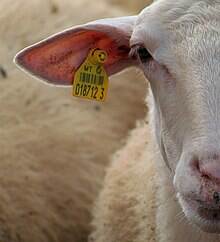
An ear tag is a plastic or metal object used for identification of domestic livestock and other animals. If the ear tag uses Radio Frequency Identification Device (RFID) technology it is referred to as an electronic ear tag. Electronic ear tags conform to international standards ISO 11784 and ISO 11785 working at 134.2 kHz, as well as ISO/IEC 18000-6C operating in the UHF spectrum. There are other non-standard systems such as Destron working at 125 kHz. Although there are many shapes of ear tags, the main types in current use are as follows:
Each of these except the metal type may carry a RFID chip, which normally carries an electronic version of the same identification number.
An ear tag usually carries an Animal Identification Number (AIN) or code for the animal, or for its herd or flock. Non electronic ear tags may be simply handwritten for the convenience of the farmer (these are known as "management tags"). Alternatively this identification number (ID) may be assigned by an organisation which is a not-for-profit organisation owned by cattle, sheep, goat and pig producers and funded by a levy on livestock sales with government input; an example is the Meat and Livestock Association (MLA) of Australia.[1] Electronic tags may also show other information about the animal, including other related identification numbers; such as the Property Identification Code (PIC) for the properties the animals have been located. Depending on jurisdiction, the movement of certain species of livestock (primarily cattle, goats, sheep and pigs) must be recorded in the online database within 24 hours of the movement; and include the PICs of the properties the animals are travelling between.
The National Livestock Identification System (NLIS) of Australia regulations require that all cattle be fitted with a RFID device in the form of an ear tag or rumen bolus (a cylindrical object placed in the rumen)[2][3] before movement from the property and that the movement be reported to the NLIS. However, if animals are tagged for internal purposes in a herd or farm, IDs need not be unique in larger scales. The NLIS now also requires sheep and goats to use an ear tag that has the Property Identification Code inscribed on it. These ear tags and boluses are complemented by transport documents supplied by vendors that are used for identification and tracking.
A similar system is used for cattle in the European Union (EU), each bovine animal having a passport document and tag in each ear carrying the same number. Sheep and goats in the EU have tags in both ears, the carrying the official number of their flock and also for breeding stock an individual number for each animal; in case of sheep or goats intended for intra-community trade, one of these tags (the left one) must have a RFID chip (or the chip may instead be carried in a rumen bolus or on an anklet).[4] Pigs are required in the EU to carry in one of the ears a tag with the number of the herd of birth, as well as with the numbers of any other herds the pig was kept with for more than 30 days; tattooing may be used as a replacement.
An ear tag can be applied with an ear tag applicator, however there are also specially-designed tags that can be applied by hand. Depending on the purpose of the tagging, an animal may be tagged on one ear or both. There may be requirements for the placement of ear tags, and care must be taken to ensure they are not placed too close to the edge of the ear pinnae; which may leave the tag vulnerable to being ripped out accidentally. If there exists a national animal identification programme in a country, animals may be tagged on both ears for the sake of increased security and effectiveness, or as a legal requirement.[5] If animals are tagged for private purposes, usually one ear is tagged. Australian sheep and goats are required to have visually readable ear tags printed with a Property Identification Code (PIC). They are complemented by movement documents supplied by consignors that are used for identification and tracking.
Very small ear tags are available for laboratory animals such as mice and rats. They are usually sold with a device that pierces the animal's ear and installs the tag at the same time. Lab animals can also be identified by other methods such as ear punching or marking (also used for livestock; see below), implanted RFID tags (mice are too small to wear an ear tag containing an RFID chip), and dye.
 Hot News
Hot News2024-10-15
2024-04-12
2024-04-12
2024-03-20
2024-03-20
2024-03-20